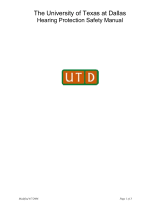
Similarly, bone conduction is insignifi-
cant compared to normal air conduction
unless the HPD’s attenuation ap-
proaches the 50 dB limitation imposed
by bone vibration, a limitation which is
constant regardless of sound level.
Thus, if a muff or a plug offers bone con-
duction limited protection at a low sound
level, the same will hold true at a high
sound level.
Since the areas of the skull around the
external ear are only a small portion of
the total bone conduction mechanism,
covering them with an earmuff is of small
significance, perhaps 3-4 dB in the 1-2
kHz region
5
. Thus the relative perfor-
mance of plugs compared to muffs is
not, in practice, determined by the bone
conduction paths but by factors inher-
ent in the design of the HPDs and their
interface to the head. In fact, a well de-
signed insert such as a foam earplug,
can offer attenuation comparable to or
exceeding that of earmuffs at most fre-
quencies.
Question:
Since my entire head is affected by the
sound and can transmit energy to my
inner ear, does a hard hat, which cov-
ers part of my skull, reduce the bone
conduction?
Response:
In order to block the sound and reduce
the bone vibration, it would be neces-
sary to wear a completely rigid helmet
with a face plate that formed a virtual
airtight enclosure about the head. A
hard hat, which covers only part of the
head and has many gaps through which
the acoustical energy can penetrate, is
of little value in reducing the ear’s re-
sponse to the bone conducted sound.
Question:
Are your hearing protectors either ANSI
or OSHA approved?
Response:
ANSI does not approve hearing protec-
tors. The ANSI standard, S3.19-1974,
As the illumination outside the closet
increases, additional light enters the
keyhole, but the ratio of the keyhole light
to the light passing through the door
remains constant.
describes how to measure the attenua-
tion of HPDs. Testing a device by the
methods of that standard in no way con-
fers any approval or attributes any par-
ticular degree of quality to the device. It
simply characterizes the laboratory at-
tenuation of the protector, however good
or bad that may be. In addition, no fed-
eral or state agencies or other U.S. stan-
dards writing organizations (see Table
1) approve or disapprove of particular
HPDs, although the EPA currently re-
quires labeling of HPD packaging
6
.
The only other agency with a hearing
protection related regulation is OSHA,
whose Hearing Conservation Amend-
ment
7
requires the HPDs that are used
reduce an employee’s 8 hour time
weighted average noise exposure to 90
dBA or less, and in the case of employ-
ees demonstrating significant threshold
shifts, to 85 dBA or less. The method for
assessing the amount of reduction to be
expected from HPDs is outlined in Ap-
pendix B of the amendment.
Question:
Can I hurt my eardrum if I insert a plug
too deeply or remove it too quickly?
Response:
The sensitivity of the adult ear canal to
pressure or pain increases significantly
as the eardrum is approached. The dis-
comfort experienced due to touching
these deeper portions of the canal will
alert the user to stop pushing on the plug
before the device reaches the eardrum
8
.
Furthermore, the design of most inserts
will prevent inserting them the length
required (about 22 mm) to touch the
eardrum. A more likely problem is ear-
wax impaction, which can result from the
insertion of earplugs, particularly of the
pre-molded variety. For this reason, the
person fitting earplugs should visually
examine the ear canal up to the depth
that the plug will be inserted. Persons
with chronic earwax impaction problems
should consider using semi-aural or
circumaural HPDs.
For plugs that create an airtight seal,
such as pre-molded inserts, rapid re-
moval can be painful and potentially
damaging to the eardrum. The plugs
should be removed with a slow twisting
motion to gradually break the seal as
they are extracted from the ear. With
foam and fibrous plugs, which do not
create a pneumatic seal (and hence
cause less of a blocked-up feeling),
there is little possibility of generating a
sudden large pressure change upon
rapid removal, and thus virtually no like-
lihood of damaging or rupturing the ear-
drum.
In EARLog #10 we will conclude this dia-
logue portion of the EARLog series.
References and Footnotes
E•A•RLog® is a registered trademark of Aearo Company. Copyright 1996. First printing 1982.
LIT. CODE 30301 2/99 AG
SELECTED FEDERAL AND
NATIONAL AGENCIES
RESPONSIBLE FOR
DOCUMENTS RELATING
TO NOISE
ANSI
American National Standards Institute
ASTM
American Society for Testing and Materials
EPA
Environmental Protection Agency
MSHA
Mine Safety and Health Administration
NIOSH
National Institute for Occupational Safety
and Health
OSHA
Occupational Safety and Health
Administration
Table 1
Berger, E.H. - The EARLog Series, is available upon
request from Aearo Company.
Council for Accreditation in Occupational Hearing Con-
servation (1978).
CAOHC Manual
, edited by M.H. Miller.
Fischler’s Printing, Cherry Hill, NJ.
E-A-RCAL
SM
Laboratory Internal Research Notes,
N2719 49.
Berger, E.H. (1980). EARLog #5 - Hearing Protector
Performance: How They Work - and - What Goes Wrong
in the Real World, available upon request from Aearo
Company.
Berger, E.H. and Kerivan, J.E. (1982). “A Rigorous Ex-
amination of the Real-Ear Attenuation at Threshold
Method (125 Hz-2kHz),” J. Acoust. Soc. Am. Suppl. 1,
Vol. 71, S52.
EPA (1979). Noise Labeling Requirements for Hearing
Protectors, Federal Register, Vol. 42, No. 190, 40 CFR
Part 211, 56139-56147. NOTE - Regulation currently
unenforced due to EPA budget and manpower reduc-
tions.
OSHA (1983). Occupational Noise Exposure; Hearing
Conservation Amendment. Federal Register, Vol. 48,
No. 46, 9738-9783.
Gasaway, D.C. (1982). Personal communication based
upon 22 years of experience supervising the USAF
hearing conservation program, during which time there
was not a single verifiable incident of eardrum dam-
age due to HPD usage.
1.
2.
3.
4.
5.
6.
7.
8.





